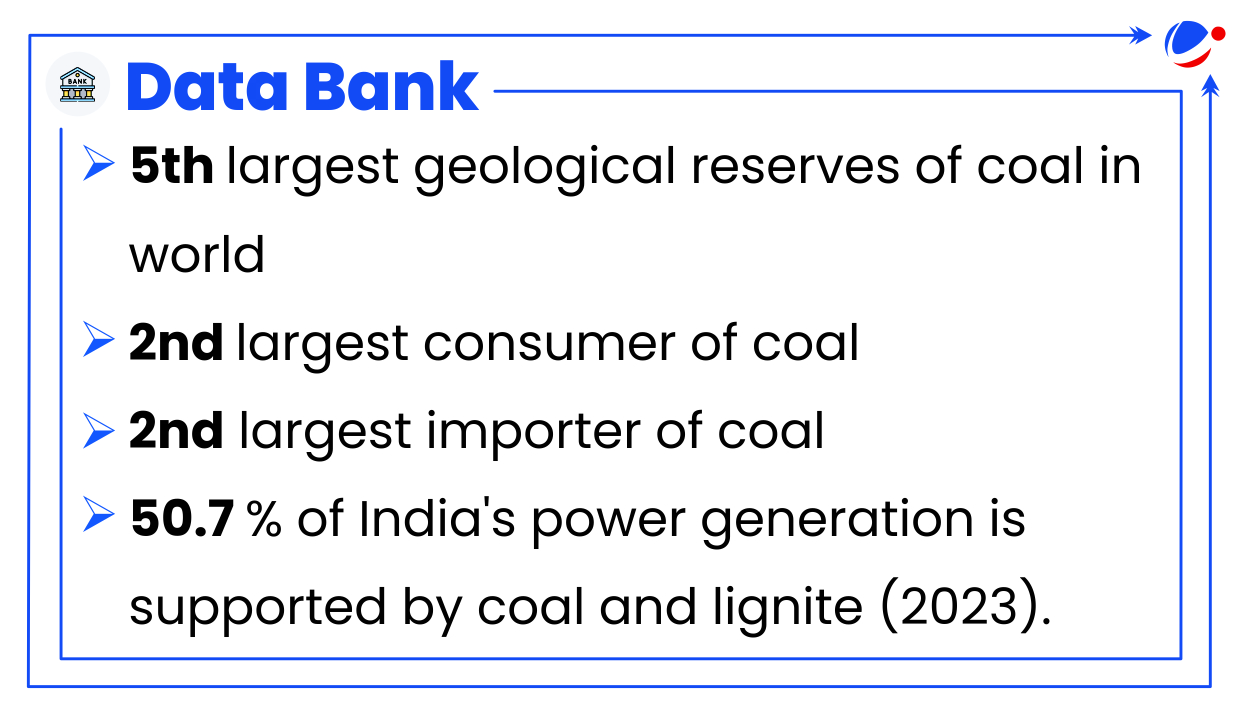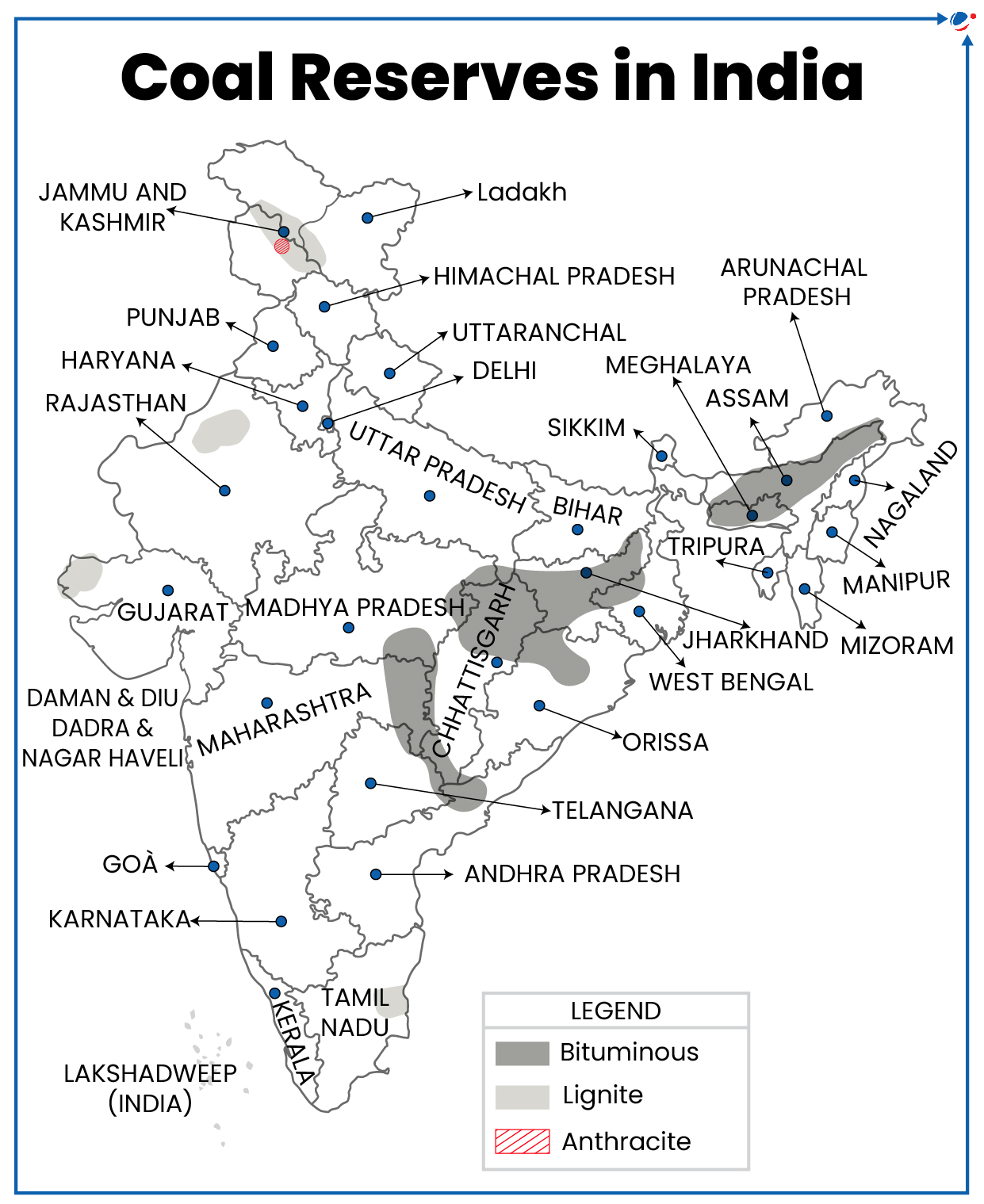Why in the News?
Ministry of Coal has informed that Compound Annual Growth Rate (CAGR) of imported coal share fell from 13.94% (2004-05 to 2013-14) to -2.29% (2014-15 to 2023-24).

Key Reforms/Initiatives in Coal Sector which helped decrease imports
- Enactment of Coal Mines (Special Provisions) CMSP Act- 2015: The Act permitted auction of coal mines for commercial mining by private entities.
- In 2020, first commercial coal mining auctions were launched.
- Mines and Minerals (Development and Regulation) Amendment Act, 2021: It emphasized on enhancing transparency and efficiency in the allocation of mining licenses. Allowed Composite Prospecting Licence-cum-Mining Lease (PL-cum-ML) specifically for coal.
- Composite PL-cum-ML is a two-stage concession granted for the purpose of undertaking prospecting operations followed by mining operations in a seamless manner.
- Also, it relaxed the end use restriction of coal by the captive miners.
- National Coal Index (NCI): NCI is a price index combining the prices of coal from all the sales channels- Notified Prices, Auction Prices and Import Prices. It serves as a reliable indicator of market dynamics, providing valuable insights of price fluctuation.
- FDI and Technological Advancement: Allowing 100% FDI in coal mining has attracted global expertise and advanced technologies.
- Amendment to NCDP: New Coal Distribution Policy, 2007, has been amended to allow transparent and objective sales of coal from closed/abandoned/discontinued mines.
Recent Initiatives which will Further promote domestic production
|
Persistent Issues/Challenges in Coal Sector
- High Import Dependence: It is mainly because there is less availability of high gross calorific value (GCV) coal in India. This type of coal has low ash and sulphur content.
- Major source countries for India's coal imports include – Australia, Russia, South Africa, the US, etc.
- Sectors like Iron and steel are major importer of coking coal.
- Coking coal produced in the country has ash between 28 to 42%. On the other hand, ash percentage in imported coking coal is less than 10%.
- Dominance of Coal India Limited: Coal India Limited (CIL) contributes over 80% of the country's indigenous coal production and supply.
- Earlier, the Competition Commission of India in 2017 had contended that Coal India and its subsidiaries operated independently of market forces and enjoyed market dominance in the relevant market with respect to production and supply of non-coking coal in India.
- CIL was found to be supplying lower quality of the essential resource at higher prices and placing opaque conditions in the contract about supply parameters and quality.
- Lack of Upgradation: Technological obsolescence in mining techniques resulting in lower productivity, higher costs, and safety hazards.
- Logistics Issue: Higher coal logistics costs owing to limited multi-modal transport approach.
- Environment Issues: The damage from open-cast mining is irreparable, rendering the land useless.
- Developing new coal mines: Land acquisition is key issue in it. Also, some times, requires displacement of the people.
- Other:
- Non-payment of outstanding dues by Power sector consumers.
- Frequent labour/ Industrial relations issues in the coal fields.
- Un-seasonal and extended rainfall in the coal bearing areas.
Way Forward
- Promoting Sustainable Practices: Miyawaki plantation method can be used on large scale promote green cover near mines.
- Encouraging Private players: It will reduce burden on Coal India Limited (CIL). Also, they will promote technological upgradation in mining.
- For Import Substitution, the Inter-Ministerial Committee in its report has suggested-
- Promotion of Rationalization of coal linkage policy.
- Rationalization of coal linkages aims to reduce the distance in transportation of coal from the coal mines to the consumer.
- Early operationalization of Captive/Commercial coal blocks.
- Ministry of Power may need to mandate the Domestic based coal power plants for using domestic coal instead of imported coal. For this, Coal Ministry needs to adequate supply and no logistic constraint of domestic coal.
- Enhance coal gasification in country to produce synthetic gas for steel sector which is mainly depended on imported coal.
- Promotion of Rationalization of coal linkage policy.
About Coal
Types of coal found in India
 |



